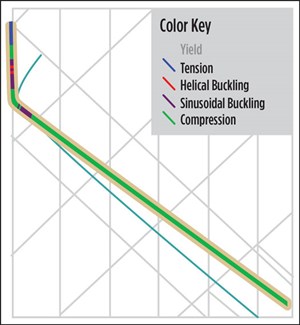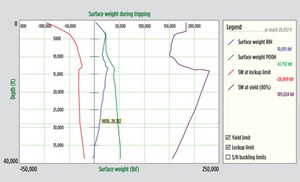Unique snubbing unit cleans out long section of decommissioned pipeline in one trip
Pipeline decommissioning can involve the practice of recovering, cutting, washing out and disposing of the pipeline on land, or flushing, cleaning, capping, burying, covering, surveying and leaving in situ on the sea floor. A pigging program may be deployed when the pipeline is left on the sea floor, which requires the pipeline to be circulated from one end to the other. Regulatory requirements can be met via other methods if circulation is impossible, for example, by using a snubbing/hydraulic workover (HWO) unit and a DP3 semisubmersible well intervention and construction vessel.
SBS Energy Services (SBS), in partnership with Helix Energy Solutions Group, successfully completed a multi-phase project in 22 days in fourth-quarter 2020. Approximately 29,000 ft of 10-in. by 6-in. concentric insulated pipeline were decommissioned in a 3,281-ft water depth in the Gulf of Mexico. The successful completion of this project marked a new offshore snubbing/HWO unit world record.
In the second critical phase of the four-phase project, the service company utilized a 340K snubbing/HWO unit to rig up and intervene inside the pipeline with an optimized drill pipe string to perform washing/flushing operations until reaching the second pipeline end termination (PLET). Some basic tenants that were established for phase two, which drew on previous successes/and lessons learned in offshore, snubbing and coiled tubing experience, were:
- Carry out a variety of torque and drag iterations to optimize practicality, supply chain availability and work string
design. - Simplify the bottomhole
assembly (BHA). - Deliver sufficient hydraulic horsepower and high flowrates to clean debris from the pipeline.
- Devise optimum pre-plan trip schedule of the ideal depth to trip/snub/rotate/snub rotate.
- Maximize communication with operations ahead of deployment.
- Adhere to a one-trip in/one trip out philosophy.
PRE-JOB MODELING
A semisubmersible well intervention and construction vessel was used in the project and the vessel platform and snubbing/HWO equipment plus ancillary equipment enabled a high level of control while cleaning out the pipeline.

Step 1–pre-job pipeline survey data. Analog data were evaluated and converted to survey data by coordinating with the vessel’s pipe lay survey, combined with the pipeline layout on the sea floor, Fig. 1.
Step 2–run force calculations. The best design of the 2.875-in. OD work string to be successfully tripped in the inner 6-in. nominal pipeline with adequate margin was determined after multiple iterations. Following force modeling, the best pre-plan trip schedule was created, using the optimum depth to trip/snub/rotate/snub and rotate for the most efficient trip in time, Fig. 2.

Step 3–develop endurance fatigue graph (S-N Curve). The calculations
in the graph indicated that the work string could rotate with infinite cycle life, due to stresses, and not exceed the endurance limit.
Step 4–use of rotary torque schedule. This was used to prevent over-torqueing the work string when depth varied relative to the pipeline. The hydraulic circuit was reset at periodic intervals.
Step 5–perform fluid circulation calculations. The fluid circulation calculations estimated 3.5 bpm and less than 5,000 psi, 428 hhp were the proper flowrate and horsepower range to sufficiently eliminate pipeline debris.
Step 6–perform nozzle sizing sensitivity. This involved balancing the number of nozzles and diameters with sufficient pressure drop, jet velocity, impact force and hydraulic horsepower. Since the snubbing/HWO unit and drill pipe work string option made it possible to reach the target depth, there was no need to add extra BHA components. A heavy-duty BHA approach reduced the likelihood of the BHA failing, maximized fluid circulation horsepower availability and reduced the need to trip out of the pipeline to repair or replace the BHA.
ONE TRIP OPERATION
The team was able to successfully trip in one time and trip out the work string to the 28,789-ft actual pipe measurement; 3,281-ft water depth, 25,069-ft (4.75 miles) lateral and flush the pipeline. Summary of steps taken:
- Pipeline hung off at semisubmersible’s drill floor.
- The 340k snubbing/HWO unit system and customized BOP stack rigged up on the end of exposed 10-in. x 6-in. pipeline prepared with welded flange.
- Custom 2.875-in. drill pipe and 2.875-in. tubing work string was tripped in the pipeline.
- BHA comprised of a nipple and a custom junk mill/jet nozzle.
- Treated calcium chloride fluid and pipe-on-pipe additive were heated and circulated to clean out debris and mitigate hydrate formation.
- Pipeline filled with seawater and capped.
The snubbing/HWO unit tripped in as far as possible, then snubbed/pushed until the maximum allowable snub force was achieved, while pipe-on-pipe additive was introduced into the circulation system, as needed. When the snubbing limit was reached, the rotary torque was engaged, and the work string continued to be tripped in. When the work string would not trip with its own weight, the snubbing/HWO unit rotated while pushing to the objective depth. The pipeline was circulated, and the work string was tripped out of the pipeline.
PROJECT ANALYSIS
Crucially, the snubbing/HWO unit was able to snub/push/rotate and allows for the ability to reach nearly 5 mi of extended lateral or a 7.8:1 lateral/vertical ratio. Uniquely, the pipeline lay on the seafloor has a short vertical section (3,281-ft water depth) compared to a conventional well profile (est. 10,000-ft vertical). Essentially, the weight of the tubular in the vertical is slacked off, the weight is transferred to the horizontal path and pushes the tubing in front of it along the horizontal to the objective depth. This concept works until horizontal buckling and lock-up occurs, due to frictional forces between the tubing and the casing.
Typical alternative techniques considered were the use of a coiled tubing unit/advanced BHA, a snubbing/HWO unit, or a drilling rig. A coiled tubing unit can push and pull, but not rotate; a drilling rig can rotate and pull, but not push. However, the snubbing/HWO unit can push, pull, rotate, and concurrently push and rotate and advanced BHAs can be attached to each if required. Some key features that contributed to the project’s success are summarized below:
Use of a thermal reactive water heater system. This technique aided softening hydrocarbon deposits in the pipeline ahead of cleaning out. Care was taken to ensure that enough capacity with redundancy was available on the semi-submersible vessel deck to not hinder the circulation rates pumped.
Use of pipe-on-pipe friction reducer additive. This increased the trip depth and lowered the trip forces and is a characteristic technique in coiled tubing operations. The method was adapted to this project, and efficiency was observed when both pumping the chemical intermittently, or as a batch treatment.
New torque lock system. Over a 28,789-ft trip in operation, this new torque lock device will be used more than 2,300 times, resulting in time savings of up to three days. This system, which was designed, engineered and manufactured to store, transfer and maintain residual torque energy while washing and rotating, requires a compact hydraulic traveling torque lock clamp device and a lower stationary torque lock clamp device to work in tandem. It maintains internal residual downhole torque through each stroke and while making up or breaking out joints. The system also mitigates torsional and axial shock loads to increase trip speed and operational efficiency without having to release the system torsion on each stroke.
Use of heavy-duty hydraulic bypass swivel. The bypass swivel boosted safety and maximized efficiency by removing the need for workers to climb and attach hydraulic hoses. The swivel is designed to hold the design push/pull axial loads while providing a pressurized flow path from a stationary spool to an upper rotational spool.
CONCLUSION
Deepwater GOM assets are in a continuous state of maturation, requiring a mounting provision of large-scale decommissioning services, including pipeline decommissioning. This project demonstrated that the snubbing/HWO unit and vessel configuration approach is an environmentally safe and cost-efficient option for pipeline clean-outs. The work string tripped in over one mile (5,280 ft) farther than the best multi-trip attempt by coiled tubing in a side-by-side comparison, and the snubbing/HWO system is capable of even greater distances than observed on this project.
ACKNOWLEDGMENTS
SBS Energy Services and Omicron Project Consulting would like to thank the GOM operator, Helix Energy Solutions Group and the Q4000 vessel and crew. The authors also would like to thank SBS’s support staff and crew members for their dedication, professionalism, teamwork culture and safety practices.
- Advancing offshore decarbonization through electrification of FPSOs (March 2024)
- Subsea technology- Corrosion monitoring: From failure to success (February 2024)
- U.S. producing gas wells increase despite low prices (February 2024)
- U.S. drilling: More of the same expected (February 2024)
- Driving MPD adoption with performance-enhancing technologies (January 2024)
- Digital transformation: A breakthrough year for digitalization in the offshore sector (January 2024)
- Applying ultra-deep LWD resistivity technology successfully in a SAGD operation (May 2019)
- Adoption of wireless intelligent completions advances (May 2019)
- Majors double down as takeaway crunch eases (April 2019)
- What’s new in well logging and formation evaluation (April 2019)
- Qualification of a 20,000-psi subsea BOP: A collaborative approach (February 2019)
- ConocoPhillips’ Greg Leveille sees rapid trajectory of technical advancement continuing (February 2019)


